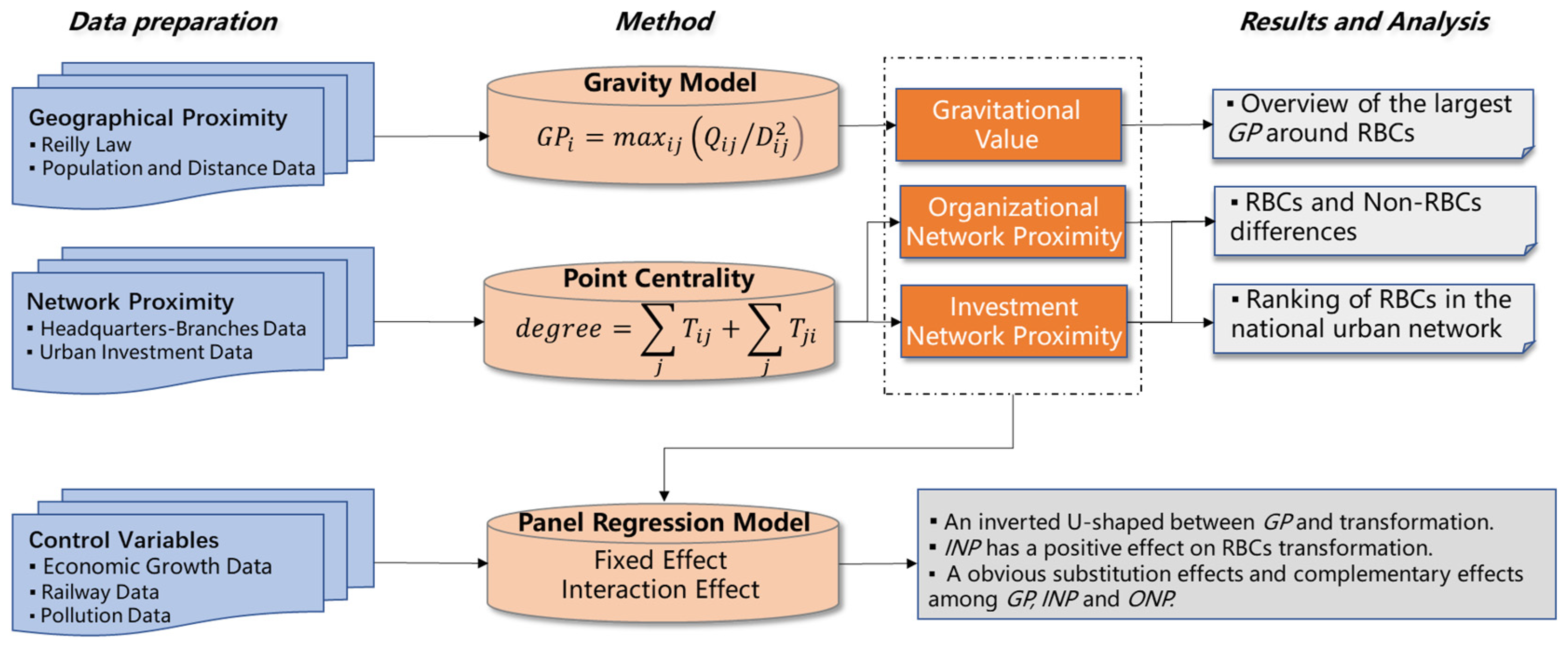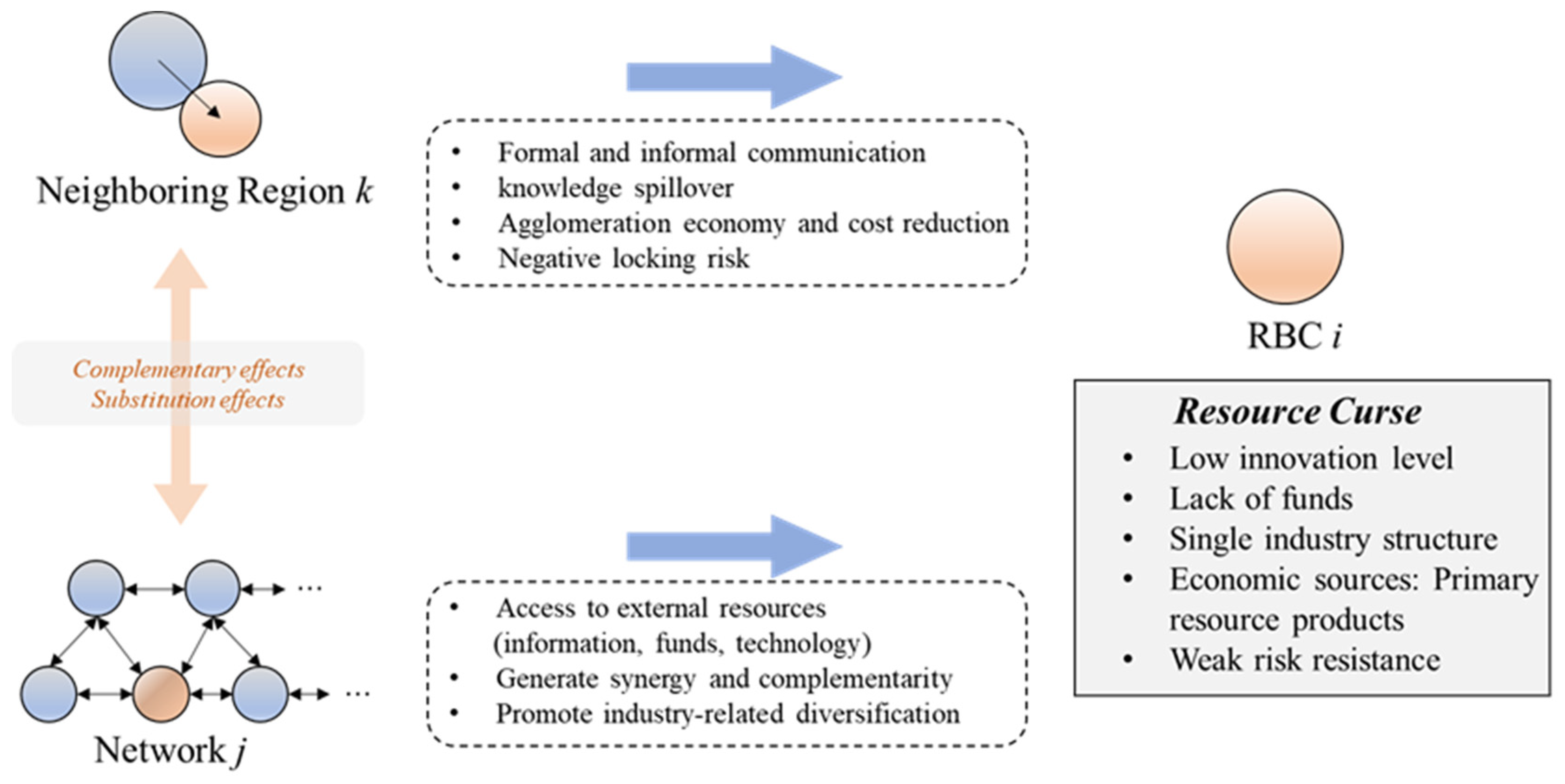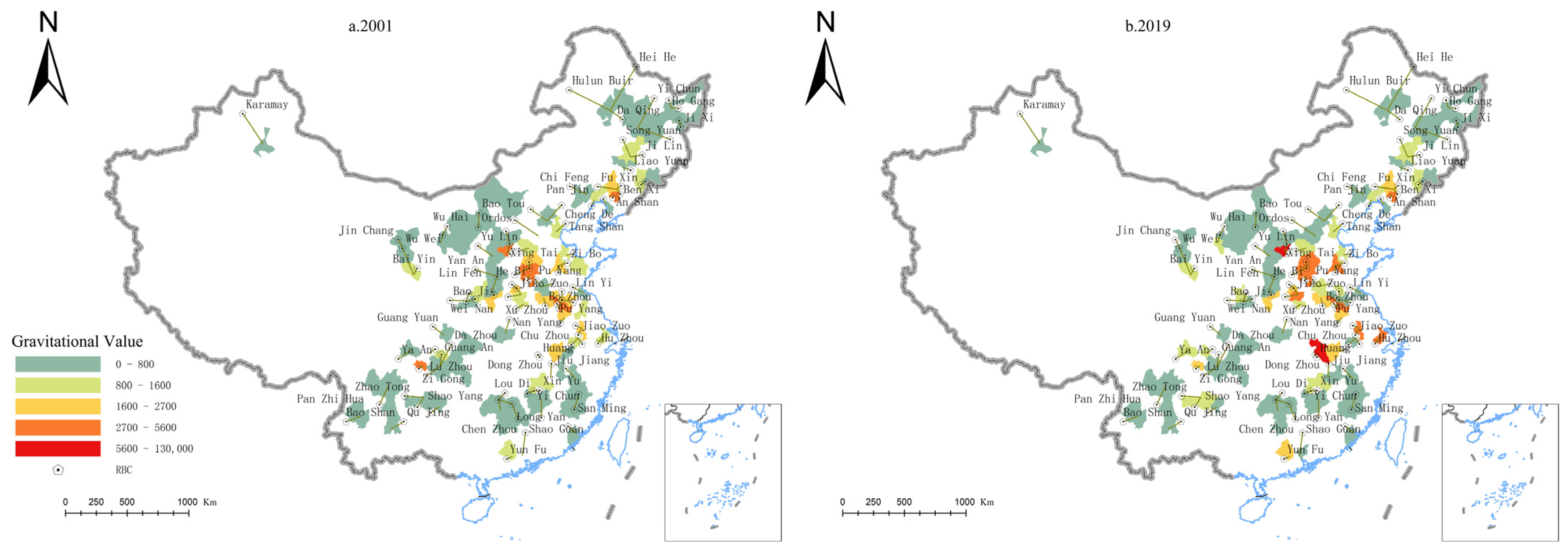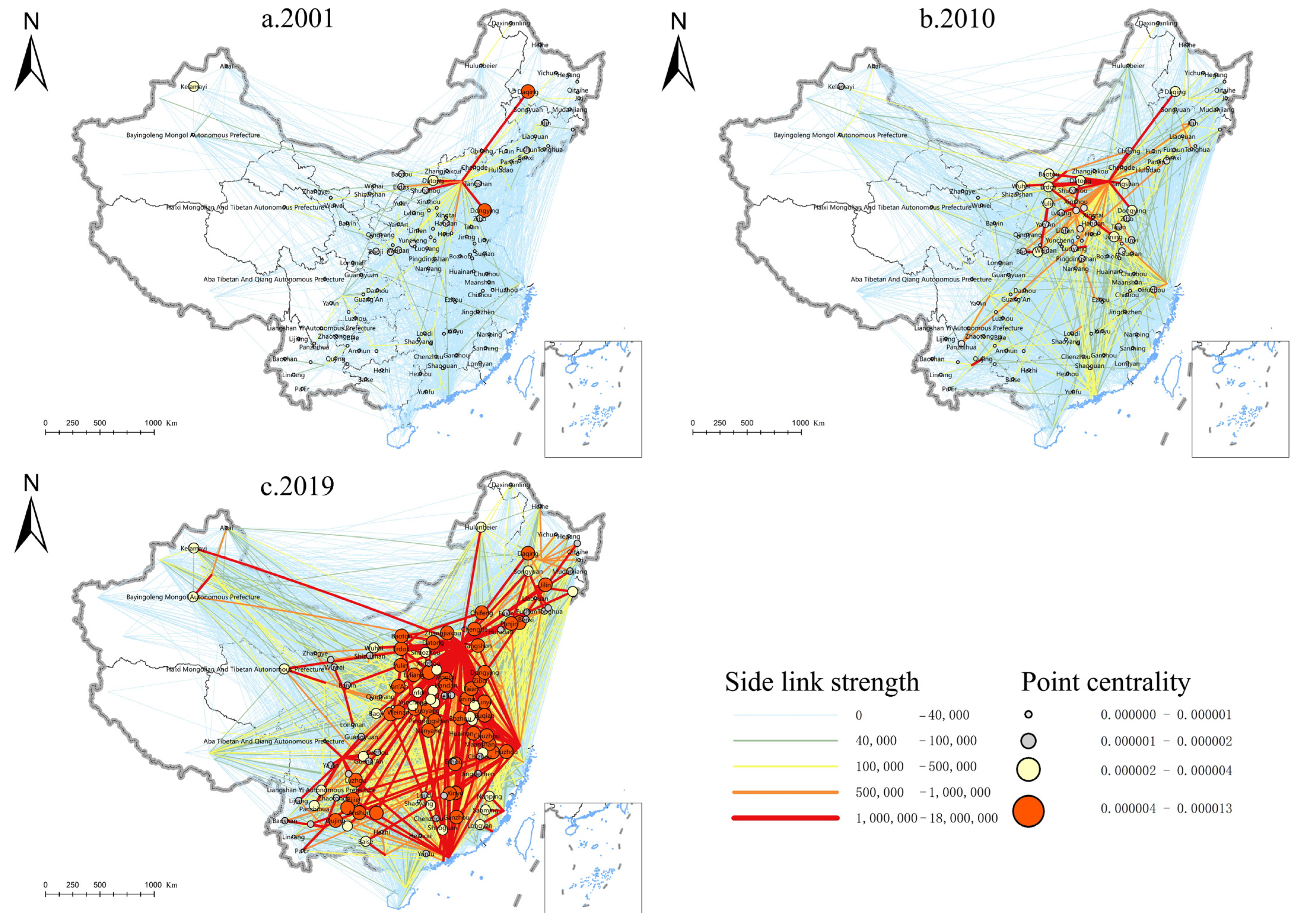The Role of Proximity in Transformational Development: The Case of Resource-Based Cities in China
Abstract
1. Introduction
2. Theoretical Framework
3. Data and Methods
3.1. Data
3.2. Proximity Measure
3.2.1. Geographical Proximity
3.2.2. Network Proximity
3.3. Econometric Model
4. Geographical Proximity and Network Proximity Characteristics Analysis
4.1. Geographical Proximity of RBCs
4.2. Network Proximity of RBCs
5. Impact of Geographical Proximity and Network Proximity on Transformation
6. Conclusions and Discussion
- (1)
- In terms of the changes in the gravitational values of the neighboring cities of RBCs, the gravitational values of the neighboring cities of RBCs were relatively stable overall from 2001 to 2019, with an equal number of RBC provincial capitals, RBC–RBC, and RBC–non-RBC combination types. The cities with good transformation results were mainly RBC–non-RBC combinations, and the gravitational values of their neighboring cities were generally in the middle of the range, which, to a certain extent, also indicates that RBCs are at risk of being adversely affected by the “ self-enriching” effect of their cores, if they rely too much on regional centers, such as provincial capitals.
- (2)
- In terms of the national network of cities, the ranking of resource cities in both the national organizational network and the national investment network increased significantly during 2001–2019. The spatial distribution of cities with high proximity to the organizational network of RBCs had obvious clustering characteristics, and the layout of the headquarters of the firms’ branches showed a single core characteristic of “Beijing as the core”. The spatial distribution of cities with high INP of RBCs had a clear ‘core-edge’ character and a diversification of funding sources from a single source.
- (3)
- Geographical proximity and transformation are not simply linear, but rather inverted ‘U’-shaped. Excessive geographical proximity has a negative lock-in effect and, thus, inhibits industrial transformation, while investment networks proximity has a positive effect on RBCs transformation, so active integration into large regional city networks is conducive to promoting the transformation of RBCs. It is important to emphasize that there are obvious substitution effects and complementary effects among GP, INP, and ONP. In addition, environmental regulation and infrastructure development have a positive effect on transformation in RBCs.
Author Contributions
Funding
Data Availability Statement
Conflicts of Interest
References
- Li, Q.; Zeng, F.; Liu, S.; Yang, M.; Xu, F. The effects of China’s sustainable development policy for resource-based cities on local industrial transformation. Resour. Policy 2020, 71, 101940. [Google Scholar] [CrossRef]
- Mehlum, H.; Moene, K.; Torvik, R. Institutions and the Resource Curse. Econ. J. 2006, 116, 1–20. [Google Scholar] [CrossRef]
- Qin, B.; Liu, L.; Yang, L.; Ge, L. Environmental Regulation and Employment in Resource-Based Cities in China: The Threshold Effect of Industrial Structure Transformation. Front. Environ. Sci. 2022, 10, 828188. [Google Scholar] [CrossRef]
- Bradbury, J.H. Towards an Alternative Theory of Resource-Based Town Development in Canada. Econ. Geogr. 1979, 55, 147–166. [Google Scholar] [CrossRef]
- Barnes, T.J.; Britton, J.N.; Coffey, W.J.; Edcincton, D.W.; Certler, M.S.; Norcliffe, G. Canadian economic geography at the millennium. Can. Geogr.-Geogr. Can. 2000, 44, 4–24. [Google Scholar] [CrossRef]
- Zeng, L.; Wang, B.; Fan, L.; Wu, J. Analyzing sustainability of Chinese mining cities using an association rule mining approach. Resour. Policy 2016, 49, 394–404. [Google Scholar] [CrossRef]
- Shao, S.; Yang, L. Natural resource dependence, human capital accumulation, and economic growth: A combined explanation for the resource curse and the resource blessing. Energy Policy 2014, 74, 632–642. [Google Scholar] [CrossRef]
- Hu, X.; Yang, C. Institutional change and divergent economic resilience: Path development of two resource-depleted cities in China. Urban Stud. 2019, 56, 3466–3485. [Google Scholar] [CrossRef]
- Martinez-Fernandez, M.C.; Wu, C.-T. Shrinking cities in Australia. In Proceedings of the 3rd State of Australian Cities National Conference, Adelaide, Australia, 28–30 November 2007. [Google Scholar]
- Chaminade, C.; Bellandi, M.; Plechero, M.; Santini, E. Understanding processes of path renewal and creation in thick specialized regional innovation systems. Evidence from two textile districts in Italy and Sweden. Eur. Plan. Stud. 2019, 27, 1978–1994. [Google Scholar] [CrossRef]
- Isaksen, A. Industrial development in thin regions: Trapped in path extension? J. Econ. Geogr. 2015, 15, 585–600. [Google Scholar] [CrossRef]
- Barzotto, M.; Corradini, C.; Fai, F.M.; Labory, S.; Tomlinson, P.R. Enhancing innovative capabilities in lagging regions: An extra-regional collaborative approach to RIS3. Camb. J. Reg. Econ. Soc. 2019, 12, 213–232. [Google Scholar] [CrossRef]
- Noni, I.D.; Orsi, L.; Belussi, F. The role of collaborative networks in supporting the innovation performances of lag-ging-behind European regions. Res. Policy 2018, 47, 1–13. [Google Scholar] [CrossRef]
- Taylor, P.; Derudder, B. World City Network: A Global Urban Analysis; Routledge: London, UK, 2015. [Google Scholar]
- Arthur, W.B. Competing technologies, increasing returns, and lock-in by historical events. Econ. J. 1989, 99, 116–131. [Google Scholar] [CrossRef]
- Hirsch, P.M.; Gillespie, J.J. Unpacking path dependence: Differential valuations accorded history across disciplines. In Path Dependence and Creation; Psychology Press: London, UK, 2001; pp. 69–90. [Google Scholar]
- Scott, A.J. Geography and Economy: Three Lectures; OUP Oxford: Oxford, UK, 2006. [Google Scholar]
- Martin, R. Roepke lecture in economic geography—Rethinking regional path dependence: Beyond lock-in to evolution. Econ. Geogr. 2010, 86, 1–27. [Google Scholar] [CrossRef]
- Hu, X.; Li, L.; Dong, K. What matters for regional economic resilience amid COVID-19? Evidence from cities in Northeast China. Cities 2022, 120, 103440. [Google Scholar] [CrossRef]
- Zhang, Q.; Brouwer, R. Is China affected by the resource curse? A critical review of the Chinese literature. J. Policy Model. 2020, 42, 133–152. [Google Scholar] [CrossRef]
- Gelb, A.; Grasmann, S. Confronting the oil curse. Popul. Nat. Resour. 2009, 87–135. [Google Scholar]
- Gylfason, T. Natural resources, education, and economic development. Eur. Econ. Rev. 2001, 45, 847–859. [Google Scholar] [CrossRef]
- Papyrakis, E.; Gerlagh, R. Resource windfalls, investment, and long-term income. Resour. Policy 2006, 31, 117–128. [Google Scholar] [CrossRef]
- Hassink, R.; Isaksen, A.; Trippl, M. Towards a comprehensive understanding of new regional industrial path development. Reg. Stud. 2019, 53, 1636–1645. [Google Scholar] [CrossRef]
- Balletto, G.; Ladu, M.; Milesi, A.; Camerin, F.; Borruso, G. Walkable City and Military Enclaves: Analysis and Decision-Making Approach to Support the Proximity Connection in Urban Regeneration. Sustainability 2022, 14, 457. [Google Scholar] [CrossRef]
- Maskell, P.; Malmberg, A. Localised learning and industrial competitiveness. Camb. J. Econ. 1999, 23, 167–185. [Google Scholar] [CrossRef]
- Chen, L.-C.; Lin, Z.-X. Examining the Role of Geographical Proximity in a Cluster’s Transformation Process: The Case of Taiwan’s Machine Tool Industry. Eur. Plan. Stud. 2014, 22, 1–19. [Google Scholar] [CrossRef]
- Filippi, M.; Torre, A. Local organisations and institutions. How can geographical proximity be activated by collective projects? Int. J. Technol. Manag. 2003, 26, 386–400. [Google Scholar] [CrossRef]
- Howells, J.R.L. Tacit Knowledge, Innovation and Economic Geography. Urban Stud. 2002, 39, 871–884. [Google Scholar] [CrossRef]
- Kasraian, D.; Maat, K.; Van Wee, B. The impact of urban proximity, transport accessibility and policy on urban growth: A longitudinal analysis over five decades. Environ. Plan. B Urban Anal. City Sci. 2017, 46, 1000–1017. [Google Scholar] [CrossRef]
- Gil Solá, A.; Vilhelmson, B. Negotiating Proximity in Sustainable Urban Planning: A Swedish Case. Sustainability 2019, 11, 31. [Google Scholar] [CrossRef]
- Gertler, M.S. Tacit knowledge and the economic geography of context, or The undefinable tacitness of being (there). J. Econ. Geogr. 2003, 3, 75–99. [Google Scholar] [CrossRef]
- Edward, S.W.J.I.; Change, C. Will new information and communication technologies improve the codification of knowledge? Ind. Corp. Chang. 2000, 9, 361–376. [Google Scholar] [CrossRef]
- Audretsch, D.B.; Feldman, M.P. Knowledge spillovers and the geography of innovation. In Handbook of Regional and Urban Economics; Elsevier: Amsterdam, The Netherlands, 2004; Volume 4, pp. 2713–2739. [Google Scholar]
- Martin, R.; Sunley, P. Path dependence and regional economic evolution. J. Econ. Geogr. 2006, 6, 395–437. [Google Scholar] [CrossRef]
- Staber, U. Collective learning in clusters: Mechanisms and biases. Entrep. Reg. Dev. 2009, 21, 553–573. [Google Scholar] [CrossRef]
- Pflieger, G.; Rozenblat, C. Introduction. Urban Networks and Network Theory: The City as the Connector of Multiple Networks. Urban Stud. 2010, 47, 2723–2735. [Google Scholar] [CrossRef]
- Li, M.; Guo, W.; Guo, R.; He, B.; Li, Z.; Li, X.; Liu, W.; Fan, Y. Urban Network Spatial Connection and Structure in China Based on Railway Passenger Flow Big Data. Land 2022, 11, 225. [Google Scholar] [CrossRef]
- Miranda, E.; e Silva, J.B.; Costa, A.R.d. Emergence and Structure of Urban Centralities in a Medium-Sized Historic City. SAGE Open 2020, 10. [Google Scholar] [CrossRef]
- Ter Wal, A.L.J.; Boschma, R. Co-evolution of firms, industries and networks in space. Reg. Stud. 2011, 45, 919–933. [Google Scholar] [CrossRef]
- Teece, D.J.; Pisano, G.; Shuen, A. Dynamic capabilities and strategic management. Strateg. Manag. J. 1997, 18, 509–533. [Google Scholar] [CrossRef]
- Henderson, R.M.; Clark, K.B. Architectural innovation: The reconfiguration of existing product technologies and the failure of established firms. Adm. Sci. Q. 1990, 35, 9–30. [Google Scholar] [CrossRef]
- van Oort, F.; Burger, M.; Raspe, O. On the Economic Foundation of the Urban Network Paradigm: Spatial Integration, Functional Integration and Economic Complementarities within the Dutch Randstad. Urban Stud. 2010, 47, 725–748. [Google Scholar] [CrossRef]
- Brand, A.; Drewes, J.E. Identification of network cities in South Africa. GeoJournal 2021, 86, 809–830. [Google Scholar] [CrossRef]
- Hudson, R. Rethinking Change in Old Industrial Regions: Reflecting on the Experiences of North East England. Environ. Plan. A Econ. Space 2005, 37, 581–596. [Google Scholar] [CrossRef]
- Micek, G.; Gwosdz, K.; Kocaj, A.; Sobala-Gwosdz, A.; Świgost-Kapocsi, A. The role of critical con-junctures in regional path creation: A study of Industry 4.0 in the Silesia region. Reg. Stud. 2022, 9, 23–44. [Google Scholar]
- Malmberg, A.; Maskell, P. Localized Learning Revisited. Growth Chang. 2006, 37, 1–18. [Google Scholar] [CrossRef]
- Singh, J. Collaborative Networks as Determinants of Knowledge Diffusion Patterns. Manag. Sci. 2005, 51, 756–770. [Google Scholar] [CrossRef]
- Breschi, S.; Lissoni, F. Mobility of skilled workers and co-invention networks: An anatomy of localized knowledge flows. J. Econ. Geogr. 2009, 9, 439–468. [Google Scholar] [CrossRef]
- Asheim, B.T.; Isaksen, A. Regional innovation systems: The integration of local ‘sticky’ and global ‘ubiquitous’ knowledge. J. Technol. Transf. 2002, 27, 77–86. [Google Scholar] [CrossRef]
- Narin, F.; Stevens, K.; Whitlow, E.S. Scientific co-operation in Europe and the citation of multinationally authored papers. Scientometrics 1991, 21, 313–323. [Google Scholar] [CrossRef]
- Glänzel, W. National characteristics in international scientific co-authorship relations. Scientometrics 2001, 51, 69–115. [Google Scholar] [CrossRef]
- Frenken, K.K.; Ponds, R.; Van Oort, F. The citation impact of research collaboration in science-based industries: A spatial-institutional analysis. Pap. Reg. Sci. 2010, 89, 271–351. [Google Scholar] [CrossRef]
- Alderson, A.S.; Beckfield, J. Power and Position in the World City System. Am. J. Sociol. 2004, 109, 811–851. [Google Scholar] [CrossRef]
- Huang, T.; Xi, J.-C.; Ge, Q.-S. Spatial Differentiation and Integration Optimization of an Urban Agglomeration Tourism System under the Influence of High-Speed Railway Network Evolution. Appl. Spat. Anal. Policy 2019, 12, 349–376. [Google Scholar] [CrossRef]
- Li, Y.; Rybski, D.; Kropp, J.P. Singularity cities. Environ. Plan. B Urban Anal. City Sci. 2019, 48, 43–59. [Google Scholar] [CrossRef]
- Duddy, E.A. The Law of Retail Gravitation. William J. Reilly. Am. J. Sociol. 1932, 37, 826–828. [Google Scholar] [CrossRef]
- Tsouri, M. Knowledge networks and strong tie creation: The role of relative network position. J. Geogr. Syst. 2022, 24, 95–114. [Google Scholar] [CrossRef]
- Morrison, A.; Rabellotti, R. Knowledge and Information Networks in an Italian Wine Cluster. Eur. Plan. Stud. 2009, 17, 983–1006. [Google Scholar] [CrossRef]
- Sebestyén, T.; Varga, A. Research productivity and the quality of interregional knowledge networks. Ann. Reg. Sci. 2013, 51, 155–189. [Google Scholar] [CrossRef]
- Wanzenböck, I.; Scherngell, T.; Lata, R. Embeddedness of European Regions in European Union-Funded Research and Development (R&D) Networks: A Spatial Econometric Perspective. Reg. Stud. 2015, 49, 1685–1705. [Google Scholar]
- Pred, A. City-Systems in Advanced Economies: Past Growth, Present Processes and Future Development Options; Routledge: London, UK, 2017. [Google Scholar]
- Beaverstock, J.V.; Smith, R.G.; Taylor, P.J. World-city network: A new metageography? Ann. Assoc. Am. Geogr. 2000, 90, 123–134. [Google Scholar] [CrossRef]
- Derudder, B.; Taylor, P.; Ni, P.; De Vos, A.; Hoyler, M.; Hanssens, H.; Bassens, D.; Huang, J.; Witlox, F.; Shen, W.; et al. Pathways of Change: Shifting Connectivities in the World City Network, 2000–08. Urban Stud. 2010, 47, 1861–1877. [Google Scholar] [CrossRef]
- Freeman, L.C. Centrality in social networks conceptual clarification. Soc. Netw. 1978, 79, 215–239. [Google Scholar] [CrossRef]
- Chen, W.; Shen, Y.; Wang, Y. Evaluation of economic transformation and upgrading of resource-based cities in Shaanxi province based on an improved TOPSIS method. Sustain. Cities Soc. 2018, 37, 232–240. [Google Scholar] [CrossRef]
- Huang, Y.; Hong, T.; Ma, T. Urban network externalities, agglomeration economies and urban economic growth. Cities 2020, 107, 102882. [Google Scholar] [CrossRef]
- Tan, J.; Hu, X.; Hassink, R.; Ni, J. Industrial structure or agency: What affects regional economic resilience? Evidence from resource-based cities in China. Cities 2020, 106, 102906. [Google Scholar] [CrossRef]
- Ye, S.; Qian, Z. The Economic Network Resilience of the Guanzhong Plain City Cluster, China: A network analysis from the evolutionary perspective. Growth Chang. 2021, 52, 2391–2411. [Google Scholar] [CrossRef]
- Sun, W.; Li, H. Quantifying location condition of resources-exhausted cities in China. Acta Geogr. Sin. 2013, 68, 199–208. [Google Scholar]
- Hansen, T.; Coenen, L. The geography of sustainability transitions: Review, synthesis and reflections on an emergent research field. Environ. Innov. Soc. Transit. 2015, 17, 92–109. [Google Scholar] [CrossRef]





| Variable | Obs | Mean | Std. Dev. | Min | Max |
|---|---|---|---|---|---|
| RNEE | 312 | 0.89 | 0.12 | 0.43 | 1.00 |
| INP | 312 | 4,607,300.00 | 7,217,703.00 | 6482.48 | 46,000,000.00 |
| ONP | 312 | 1798.97 | 1688.94 | 109.00 | 9595.00 |
| GP | 312 | 2647.80 | 13,027.50 | 23.87 | 147,667.80 |
| FDI | 312 | 22,644.55 | 43,438.44 | 0.00 | 290,822.00 |
| PM2.5 | 312 | 41.24 | 13.86 | 14.58 | 87.47 |
| STAFF | 312 | 32,043.91 | 29,707.47 | 2164.93 | 188,857.00 |
| RGDP | 312 | 262,301.10 | 4,067,694.00 | 2165.00 | 71,900,000.00 |
| HSR | 312 | 0.26 | 0.44 | 0.00 | 1.00 |
| Dependent Variable: RNEE | ||||||
|---|---|---|---|---|---|---|
| OLS | FE | RE | OLS | FE | RE | |
| (1) | (2) | (3) | (4) | (5) | (6) | |
| lnONP | 0.0769 ** | −0.0152 | 0.0037 | 0.0833 * | −0.0107 | 0.0229 ** |
| (−4.35) | (−1.51) | (−0.38) | (−3.00) | (−0.86) | (−2.01) | |
| lnINP | −0.0293 * | 0.0195 *** | 0.0086 | −0.0263 ** | 0.0109 * | −0.0006 |
| (−4.26) | (−3.60) | (−1.62) | (−4.52) | (−1.81) | (−0.11) | |
| lnGP | −0.0032 | −0.0456 | −0.0035 | 0.00624 | −0.0468 * | 0.0045 |
| (−0.97) | (−1.64) | (−0.45) | −2.09 | (−1.70) | (−0.56) | |
| lnSTAFF | −0.0222 | −0.0337 *** | −0.0147 | |||
| (−0.71) | (−2.68) | (−1.37) | ||||
| lnFDI | 0.0020 | −0.0025 | −0.0022 | |||
| −0.41 | (−1.10) | (−0.98) | ||||
| lnPM2.5 | −0.0755 ** | −0.0481 * | −0.0534 ** | |||
| (−4.58) | (−1.76) | (−2.37) | ||||
| lnRGDP | −0.0224 | 0.0050 | −0.0098 | |||
| (−1.49) | −0.78 | (−1.64) | ||||
| HSR | 0.0273 ** | 0.0242 ** | 0.0232 ** | |||
| −6.11 | −2.23 | −2.05 | ||||
| _cons | 0.7800 * | 1.0230 *** | 0.7620 *** | 1.1770 * | 1.3700 *** | 1.0560 *** |
| −9.31 | −5.71 | −13.40 | −9.06 | −6.23 | −10.77 | |
| R2 | 0.1165 | 0.1596 | 0.1321 | 0.1862 | 0.2315 | 0.1768 |
| N | 312 | 312 | 312 | 312 | 312 | 312 |
| Dependent Variable: RNEE | ||||||
|---|---|---|---|---|---|---|
| OLS | FE | RE | OLS | FE | RE | |
| (7) | (8) | (9) | (10) | (11) | (12) | |
| lnGP2 | −0.0002 | −0.0043 ** | −0.0009 | −0.0023 | −0.0040 * | −0.0012 |
| (−0.33) | (−1.99) | (−1.13) | (−1.78) | (−1.87) | (−1.51) | |
| lnGP *lnINP | 0.0007 | 0.0012 ** | 0.0012 ** | |||
| (−0.84) | (−2.15) | (−2.31) | ||||
| lnGP *lnONP | 0.0061 | 0.0020 * | 0.0032 *** | |||
| (−2.33) | (−1.71) | (−3.08) | ||||
| lnFDI | 0.0070 | −0.0033 | −0.0016 | 0.0040 | −0.0037 | −0.0027 |
| (−1.81) | (−1.54) | (−0.79) | −0.84 | (−1.65) | (−1.26) | |
| lnPM2.5 | −0.0787 * | −0.0535 ** | −0.0471 ** | −0.0899 ** | −0.0655 ** | −0.0574 *** |
| (−4.09) | (−2.05) | (−2.18) | (−7.01) | (−2.57) | (−2.69) | |
| lnSTAFF | −0.0034 | −0.0321 *** | −0.0201 * | −0.0169 | −0.0310 ** | −0.0174 * |
| (−0.22) | (−2.67) | (−1.91) | (−0.67) | (−2.52) | (−1.65) | |
| lnRGDP | −0.0183 | 0.0019 | −0.0035 | −0.0286 | 0.0018 | −0.008 |
| (−1.26) | (−0.36) | (−0.69) | (−1.60) | (−0.30) | (−1.48) | |
| HSR | 0.0430 ** | 0.0197 * | 0.0220 ** | 0.0152 | 0.0223 ** | 0.0190 * |
| (−4.34) | (−1.77) | (−2.00) | (−1.76) | (−2.01) | (−1.74) | |
| _cons | 1.2430 ** | 1.2730 *** | 1.0940 *** | 1.3330 ** | 1.3270 *** | 1.1520 *** |
| −7.77 | −8.91 | −12.18 | −6.59 | −9.20 | −12.66 | |
| R2 | 0.0942 | 0.2296 | 0.2084 | 0.1423 | 0.2231 | 0.1966 |
| N | 312 | 312 | 312 | 312 | 312 | 312 |
Publisher’s Note: MDPI stays neutral with regard to jurisdictional claims in published maps and institutional affiliations. |
© 2022 by the authors. Licensee MDPI, Basel, Switzerland. This article is an open access article distributed under the terms and conditions of the Creative Commons Attribution (CC BY) license (https://creativecommons.org/licenses/by/4.0/).
Share and Cite
Lu, S.; Zhang, W.; Li, J.; Ma, R. The Role of Proximity in Transformational Development: The Case of Resource-Based Cities in China. Land 2022, 11, 2123. https://doi.org/10.3390/land11122123
Lu S, Zhang W, Li J, Ma R. The Role of Proximity in Transformational Development: The Case of Resource-Based Cities in China. Land. 2022; 11(12):2123. https://doi.org/10.3390/land11122123
Chicago/Turabian StyleLu, Shuo, Wenzhong Zhang, Jiaming Li, and Renfeng Ma. 2022. "The Role of Proximity in Transformational Development: The Case of Resource-Based Cities in China" Land 11, no. 12: 2123. https://doi.org/10.3390/land11122123
APA StyleLu, S., Zhang, W., Li, J., & Ma, R. (2022). The Role of Proximity in Transformational Development: The Case of Resource-Based Cities in China. Land, 11(12), 2123. https://doi.org/10.3390/land11122123








